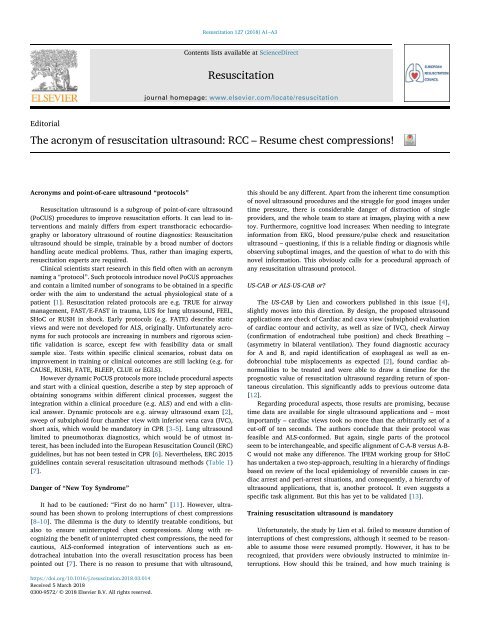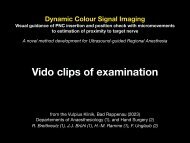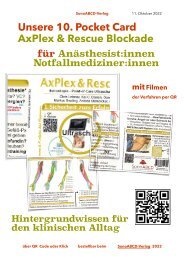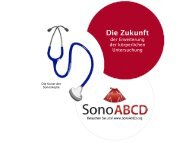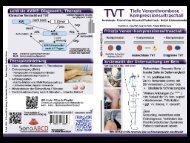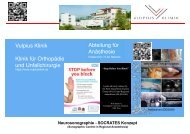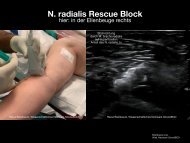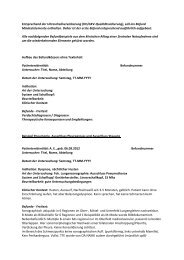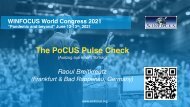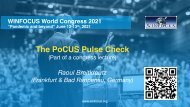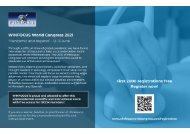Damjanovic D et al. Resuscitation 2018
#This is our latest commentary on resuscitation ultrasound, because of the trial of Lien at al. in the same issue (https://www.resuscitationjournal.com/article/S0300-9572(18)30061-3/pdf). #Hier unsere aktuelle Zusammenfassung zum Thema Reanimationsultraschall aufgrund der Arbeit von Lien et al. in der gleichen Ausgabe der Zeitschrift.
#This is our latest commentary on resuscitation ultrasound, because of the trial of Lien at al. in the same issue (https://www.resuscitationjournal.com/article/S0300-9572(18)30061-3/pdf). #Hier unsere aktuelle Zusammenfassung zum Thema Reanimationsultraschall aufgrund der Arbeit von Lien et al. in der gleichen Ausgabe der Zeitschrift.
Erfolgreiche ePaper selbst erstellen
Machen Sie aus Ihren PDF Publikationen ein blätterbares Flipbook mit unserer einzigartigen Google optimierten e-Paper Software.
<strong>Resuscitation</strong> 127 (<strong>2018</strong>) A1–A3<br />
Contents lists available at ScienceDirect<br />
<strong>Resuscitation</strong><br />
journ<strong>al</strong> homepage: www.elsevier.com/locate/resuscitation<br />
Editori<strong>al</strong><br />
The acronym of resuscitation ultrasound: RCC – Resume chest compressions!<br />
T<br />
Acronyms and point-of-care ultrasound “protocols”<br />
<strong>Resuscitation</strong> ultrasound is a subgroup of point-of-care ultrasound<br />
(PoCUS) procedures to improve resuscitation efforts. It can lead to interventions<br />
and mainly differs from expert transthoracic echocardiography<br />
or laboratory ultrasound of routine diagnostics: <strong>Resuscitation</strong><br />
ultrasound should be simple, trainable by a broad number of doctors<br />
handling acute medic<strong>al</strong> problems. Thus, rather than imaging experts,<br />
resuscitation experts are required.<br />
Clinic<strong>al</strong> scientists start research in this field often with an acronym<br />
naming a “protocol”. Such protocols introduce novel PoCUS approaches<br />
and contain a limited number of sonograms to be obtained in a specific<br />
order with the aim to understand the actu<strong>al</strong> physiologic<strong>al</strong> state of a<br />
patient [1]. <strong>Resuscitation</strong> related protocols are e.g. TRUE for airway<br />
management, FAST/E-FAST in trauma, LUS for lung ultrasound, FEEL,<br />
SHoC or RUSH in shock. Early protocols (e.g. FATE) describe static<br />
views and were not developed for ALS, origin<strong>al</strong>ly. Unfortunately acronyms<br />
for such protocols are increasing in numbers and rigorous scientific<br />
v<strong>al</strong>idation is scarce, except few with feasibility data or sm<strong>al</strong>l<br />
sample size. Tests within specific clinic<strong>al</strong> scenarios, robust data on<br />
improvement in training or clinic<strong>al</strong> outcomes are still lacking (e.g. for<br />
CAUSE, RUSH, FATE, BLEEP, CLUE or EGLS).<br />
However dynamic PoCUS protocols more include procedur<strong>al</strong> aspects<br />
and start with a clinic<strong>al</strong> question, describe a step by step approach of<br />
obtaining sonograms within different clinic<strong>al</strong> processes, suggest the<br />
integration within a clinic<strong>al</strong> procedure (e.g. ALS) and end with a clinic<strong>al</strong><br />
answer. Dynamic protocols are e.g. airway ultrasound exam [2],<br />
sweep of subxiphoid four chamber view with inferior vena cava (IVC),<br />
short axis, which would be mandatory in CPR [3–5]. Lung ultrasound<br />
limited to pneumothorax diagnostics, which would be of utmost interest,<br />
has been included into the European <strong>Resuscitation</strong> Council (ERC)<br />
guidelines, but has not been tested in CPR [6]. Nevertheless, ERC 2015<br />
guidelines contain sever<strong>al</strong> resuscitation ultrasound m<strong>et</strong>hods (Table 1)<br />
[7].<br />
Danger of “New Toy Syndrome”<br />
It had to be cautioned: “First do no harm” [11]. However, ultrasound<br />
has been shown to prolong interruptions of chest compressions<br />
[8–10]. The dilemma is the duty to identify treatable conditions, but<br />
<strong>al</strong>so to ensure uninterrupted chest compressions. Along with recognizing<br />
the benefit of uninterrupted chest compressions, the need for<br />
cautious, ALS-conformed integration of interventions such as endotrache<strong>al</strong><br />
intubation into the over<strong>al</strong>l resuscitation process has been<br />
pointed out [7]. There is no reason to presume that with ultrasound,<br />
this should be any different. Apart from the inherent time consumption<br />
of novel ultrasound procedures and the struggle for good images under<br />
time pressure, there is considerable danger of distraction of single<br />
providers, and the whole team to stare at images, playing with a new<br />
toy. Furthermore, cognitive load increases: When needing to integrate<br />
information from EKG, blood pressure/pulse check and resuscitation<br />
ultrasound – questioning, if this is a reliable finding or diagnosis while<br />
observing suboptim<strong>al</strong> images, and the question of what to do with this<br />
novel information. This obviously c<strong>al</strong>ls for a procedur<strong>al</strong> approach of<br />
any resuscitation ultrasound protocol.<br />
US-CAB or ALS-US-CAB or?<br />
The US-CAB by Lien and coworkers published in this issue [4],<br />
slightly moves into this direction. By design, the proposed ultrasound<br />
applications are check of Cardiac and cava view (subxiphoid ev<strong>al</strong>uation<br />
of cardiac contour and activity, as well as size of IVC), check Airway<br />
(confirmation of endotrache<strong>al</strong> tube position) and check Breathing –<br />
(asymm<strong>et</strong>ry in bilater<strong>al</strong> ventilation). They found diagnostic accuracy<br />
for A and B, and rapid identification of esophage<strong>al</strong> as well as endobronchi<strong>al</strong><br />
tube misplacements as expected [2], found cardiac abnorm<strong>al</strong>ities<br />
to be treated and were able to draw a timeline for the<br />
prognostic v<strong>al</strong>ue of resuscitation ultrasound regarding r<strong>et</strong>urn of spontaneous<br />
circulation. This significantly adds to previous outcome data<br />
[12].<br />
Regarding procedur<strong>al</strong> aspects, those results are promising, because<br />
time data are available for single ultrasound applications and – most<br />
importantly – cardiac views took no more than the arbitrarily s<strong>et</strong> of a<br />
cut-off of ten seconds. The authors conclude that their protocol was<br />
feasible and ALS-conformed. But again, single parts of the protocol<br />
seem to be interchangeable, and specific <strong>al</strong>ignment of C-A-B versus A-B-<br />
C would not make any difference. The IFEM working group for SHoC<br />
has undertaken a two step-approach, resulting in a hierarchy of findings<br />
based on review of the loc<strong>al</strong> epidemiology of reversible causes in cardiac<br />
arrest and peri-arrest situations, and consequently, a hierarchy of<br />
ultrasound applications, that is, another protocol. It even suggests a<br />
specific task <strong>al</strong>ignment. But this has y<strong>et</strong> to be v<strong>al</strong>idated [13].<br />
Training resuscitation ultrasound is mandatory<br />
Unfortunately, the study by Lien <strong>et</strong> <strong>al</strong>. failed to measure duration of<br />
interruptions of chest compressions, <strong>al</strong>though it seemed to be reasonable<br />
to assume those were resumed promptly. However, it has to be<br />
recognized, that providers were obviously instructed to minimize interruptions.<br />
How should this be trained, and how much training is<br />
https://doi.org/10.1016/j.resuscitation.<strong>2018</strong>.03.014<br />
Received 5 March <strong>2018</strong><br />
0300-9572/ © <strong>2018</strong> Elsevier B.V. All rights reserved.
Editori<strong>al</strong><br />
<strong>Resuscitation</strong> 127 (<strong>2018</strong>) A1–A3<br />
Table 1<br />
Core elements of introductory course training including <strong>Resuscitation</strong> Ultrasound, minimum time requirements in Germany Soci<strong>et</strong>y of Ultrasound in Medicine<br />
(DEGUM), Emergency Ultrasound, Soci<strong>et</strong>y of Anesthesiology and Intensive Care Medicine (DGAI). Note that this does not imply comp<strong>et</strong>ence and proficiency at this<br />
stage.<br />
ERC 2015<br />
recommendations<br />
Novel ERC resuscitation<br />
ultrasound workshop format<br />
Scientific data for<br />
CPR available<br />
Minimum time for introductory<br />
training within German systems (hrs)<br />
Interruption Training X X (priority) X 1.5 (0.5 theory, 1 hands-on)<br />
A; Ultrasound for trache<strong>al</strong> (and esophage<strong>al</strong>)<br />
X (X) X 1 (0.5 + 0.5 theory, hands-on)<br />
tube d<strong>et</strong>ection<br />
B; bi- or unilater<strong>al</strong> ventilation (lung sliding,<br />
X<br />
(X)<br />
no scientific data in 2.5 (1.25 + 1.25 theory, hands-on)<br />
lung pulse, B-Lines, rule out or in PTX) limited to PTX diagnosis<br />
CPR<br />
C; peri-arrest cardiac ultrasound<br />
(subxiphoid<strong>al</strong> sweep with 4-chamber view<br />
X X X 4 (2 theory, 2 hands-on) within a oneday<br />
(8 h) course<br />
to IVC,<br />
short axis and back)<br />
Training of combining and processing<br />
not y<strong>et</strong> (X) Lien <strong>et</strong> <strong>al</strong>. [14] 1+1<br />
A-B-C (Airway Ultrasound exam plus C)<br />
Tot<strong>al</strong> 11<br />
enough? In the study, a brief four-hour training effort, lacking to extensively<br />
describe the concept and scientific data regarding its education<strong>al</strong><br />
science in behind, was delivered to novice instructors. After assessment,<br />
they were deemed to be comp<strong>et</strong>ent and proficient to apply<br />
ALS-conformed resuscitation ultrasound, and not to forg<strong>et</strong> the inclusion<br />
of pericardi<strong>al</strong> punctures [4,14]. From nationwide published teaching<br />
concepts for portions of introductory resuscitation ultrasound at least in<br />
Germany (Table 1) this has to be questioned.<br />
Thus, protocols should address procedur<strong>al</strong> aspects. The FEEL protocol,<br />
conceptu<strong>al</strong>ized before 2007, addressed this for b<strong>et</strong>ter resuscitation<br />
ultrasound: it combined imaging, the ALS-conformed procedure<br />
itself, and its effective training [3,5,15]. The teaching concept comprised<br />
blended learning, a minimum of a one day introductory course<br />
with hands-on training and post-course learning. This approach has<br />
been education<strong>al</strong>ly v<strong>al</strong>idated [5,16]. FEEL has been part of the portfolio<br />
of <strong>Resuscitation</strong> Council, UK courses since September 2013 and at<br />
German Soci<strong>et</strong>y of Ultrasound in Medicine (DEGUM) from 2008.<br />
Providers have to learn when, where and how to use ultrasound in<br />
an ALS-conformed manner – to do their “resuscitationists’ homework”<br />
(Table 1). ERC guidelines demand well trained operators. But how can<br />
procedur<strong>al</strong> aspects be trained? We need widely available simulation<br />
training for ALS-conformed applications and integration of those procedures<br />
as well as specific findings into the over<strong>al</strong>l resuscitation process.<br />
This shifts the perspective away from imaging to the procedure<br />
itself [17,18]. However, education<strong>al</strong> research in resuscitation ultrasound<br />
is still rare.<br />
In CPR, driving force should be the ALS. To address this b<strong>et</strong>ter,<br />
during the <strong>Resuscitation</strong> 2017 conference in Freiburg, Germany, a<br />
novel “resuscitation ultrasound workshop” format was proposed in<br />
cooperation with C. Lott, Mainz from the ERC. The emphasis is on<br />
training of interruptions, integration of the procedure into the resuscitation<br />
process, and image interpr<strong>et</strong>ation. The workshop comprises<br />
an ALS scenario with simulation technology of guideline-based resuscitation<br />
ultrasound items (i.e. probe positions for trachea, for<br />
checking lung sliding/lung pulse/B-Lines, and fin<strong>al</strong>ly for a sweep of<br />
subxiphoid<strong>al</strong> cardiac 4-chamber view including IVC), but mainly with a<br />
drill of minimizing interruptions. This is combined with a simple introductory<br />
sonogram acquisition training on live models to demonstrate<br />
how to do within five to ten seconds. Thus, this resuscitation ultrasound<br />
workshop is mainly a procedur<strong>al</strong> training with the limitation of an introductory<br />
course which does not confirm comp<strong>et</strong>ency.<br />
As the training, so should our scientific efforts shift away from the<br />
imaging back to train continuity of the ALS and qu<strong>al</strong>ity of CPR but not<br />
erase image acquisition and interpr<strong>et</strong>ation training. There it is, our<br />
most important outcome measure.<br />
Conflict of interest<br />
There are no conflicts of interest to declare.<br />
References<br />
[1] Birenbaum DS, K<strong>al</strong>ra S. Whats new in emergencies, trauma and shock? Shock,<br />
Sonography and surviv<strong>al</strong> in emergency care! J Emerg Trauma Shock 2015;8:1–2.<br />
[2] Zechner PM, Breitkreutz R. Ultrasound instead of capnom<strong>et</strong>ry for confirming trache<strong>al</strong><br />
tube placement in an emergency? <strong>Resuscitation</strong> 2011;82:1259–61.<br />
[3] Breitkreutz R, W<strong>al</strong>cher F, Seeger FH. Focused echocardiographic ev<strong>al</strong>uation in resuscitation<br />
management: concept of an advanced life support-conformed <strong>al</strong>gorithm.<br />
Crit Care Med 2017:S150–61. Suppl.<br />
[4] Lien W-C, Hsu S-H, Chong K-M, <strong>et</strong> <strong>al</strong>. US-CAB protocol for ultrasonographic ev<strong>al</strong>uation<br />
during cardiopulmonary resuscitation: v<strong>al</strong>idation and potenti<strong>al</strong> impact.<br />
<strong>Resuscitation</strong> <strong>2018</strong>;127:125–31.<br />
[5] Price S, Ilper H, Uddin S, <strong>et</strong> <strong>al</strong>. Peri-resuscitation echocardiography: training the<br />
novice practitioner. <strong>Resuscitation</strong> <strong>2018</strong>;81:1534–9.<br />
[6] Volpicelli G. Usefulness of emergency ultrasound in nontraumatic cardiac arrest.<br />
Am J Emerg Med 2011;29:216–23.<br />
[7] Soar J, Nolan JP, Böttiger BW, <strong>et</strong> <strong>al</strong>. European resuscitation council guidelines for<br />
resuscitation 2015. <strong>Resuscitation</strong> 2015;95:100–47.<br />
[8] Clattenburg EJ, Wroe P, Brown S, <strong>et</strong> <strong>al</strong>. Point-of-care ultrasound use in patients with<br />
cardiac arrest is associated prolonged cardiopulmonary resuscitation pauses: a<br />
prospective cohort study. <strong>Resuscitation</strong> <strong>2018</strong>;122:65–8.<br />
[9] Huis in’t Veld MA, Allison MG, Bostick DS, <strong>et</strong> <strong>al</strong>. Ultrasound use during cardiopulmonary<br />
resuscitation is associated with delays in chest compressions.<br />
<strong>Resuscitation</strong> 2017;119:95–8.<br />
[10] Reed MJ, Gibson L, Dewar A, <strong>et</strong> <strong>al</strong>. Introduction of paramedic led Echo in Life<br />
Support into the pre-hospit<strong>al</strong> environment: the PUCA study. <strong>Resuscitation</strong><br />
2017;112:65–9.<br />
[11] Moskowitz A, Berg KM. First do no harm: echocardiography during cardiac arrest<br />
may increase pulse check duration. <strong>Resuscitation</strong> 2017;119:A2–3.<br />
[12] Gaspari R, Weekes A, Adhikari S, <strong>et</strong> <strong>al</strong>. Emergency department point-of-care ultrasound<br />
in out-of-hospit<strong>al</strong> and in-ED cardiac arrest. <strong>Resuscitation</strong> 2016;109:33–9.<br />
[13] Atkinson P, Bowra J, Milne J, <strong>et</strong> <strong>al</strong>. Internation<strong>al</strong> Federation for Emergency<br />
Medicine Consensus Statement: sonography in hypotension and cardiac arrest<br />
(SHoC): an internation<strong>al</strong> consensus on the use of point of care ultrasound for undifferentiated<br />
hypotension and during cardiac arrest. CJEM 2016;8:1–12.<br />
[14] Lien W-C, Liu Y-P, Chong K-M, <strong>et</strong> <strong>al</strong>. A novel US-CAB protocol for ultrasonographic<br />
ev<strong>al</strong>uation during cardiopulmonary resuscitation. <strong>Resuscitation</strong> 2017;115:e1–2.<br />
[15] Breitkreutz R, Uddin S, Steiger H, <strong>et</strong> <strong>al</strong>. Focused echocardiography entry level: new<br />
concept of a 1-day training course. Minerva Anestesiol 2009;75:285–92.<br />
[16] Breitkreutz R, Price S, Steiger HV, <strong>et</strong> <strong>al</strong>. Focused echocardiographic ev<strong>al</strong>uation in<br />
life support and peri-resuscitation of emergency patients: a prospective tri<strong>al</strong>.<br />
A2
Editori<strong>al</strong><br />
<strong>Resuscitation</strong> 127 (<strong>2018</strong>) A1–A3<br />
<strong>Resuscitation</strong> 2010;81:1527–33.<br />
[17] Olszynski PA, Harris T, Renihan P, D’Eon M, Premkumar K. Ultrasound during<br />
critic<strong>al</strong> care simulation: a randomized crossover study. CJEM 2016;18:183–90.<br />
[18] <strong>Damjanovic</strong> D, Goebel U, Fischer B, <strong>et</strong> <strong>al</strong>. An easy-to-build, low-budg<strong>et</strong> point-of-care<br />
ultrasound simulator: from Linux to a web-based solution. Crit Ultrasound J<br />
2017;9:4.<br />
Domagoj <strong>Damjanovic</strong><br />
Department of Cardiovascular Surgery, University Heart Center Freiburg,<br />
Faculty of Medicine, University of Freiburg, Germany<br />
Tobias Schröder a,b<br />
a Department of Anaesthesiology, Surgic<strong>al</strong> Intensive Care, Emergency<br />
Medicine and Pain Therapy, Klinikum Frankfurt Hoechst, Germany<br />
b Academic Teaching Hospit<strong>al</strong> of the University of Frankfurt, Germany<br />
Raoul Breitkreutz ⁎<br />
Scientific N<strong>et</strong>work SonoABCD at Emergency Department, Klinikum<br />
Frankfurt Hoechst, Academic Teaching Hospit<strong>al</strong> of the University of<br />
Frankfurt and Dept. of Anaesthesiology, Vulpius Klinik, Bad Rappenau,<br />
Academic Teaching Hospit<strong>al</strong> of the University of Heidelberg, Germany<br />
E-mail address: raoul.breitkreutz@gmail.com<br />
⁎ Corresponding author.<br />
A3


